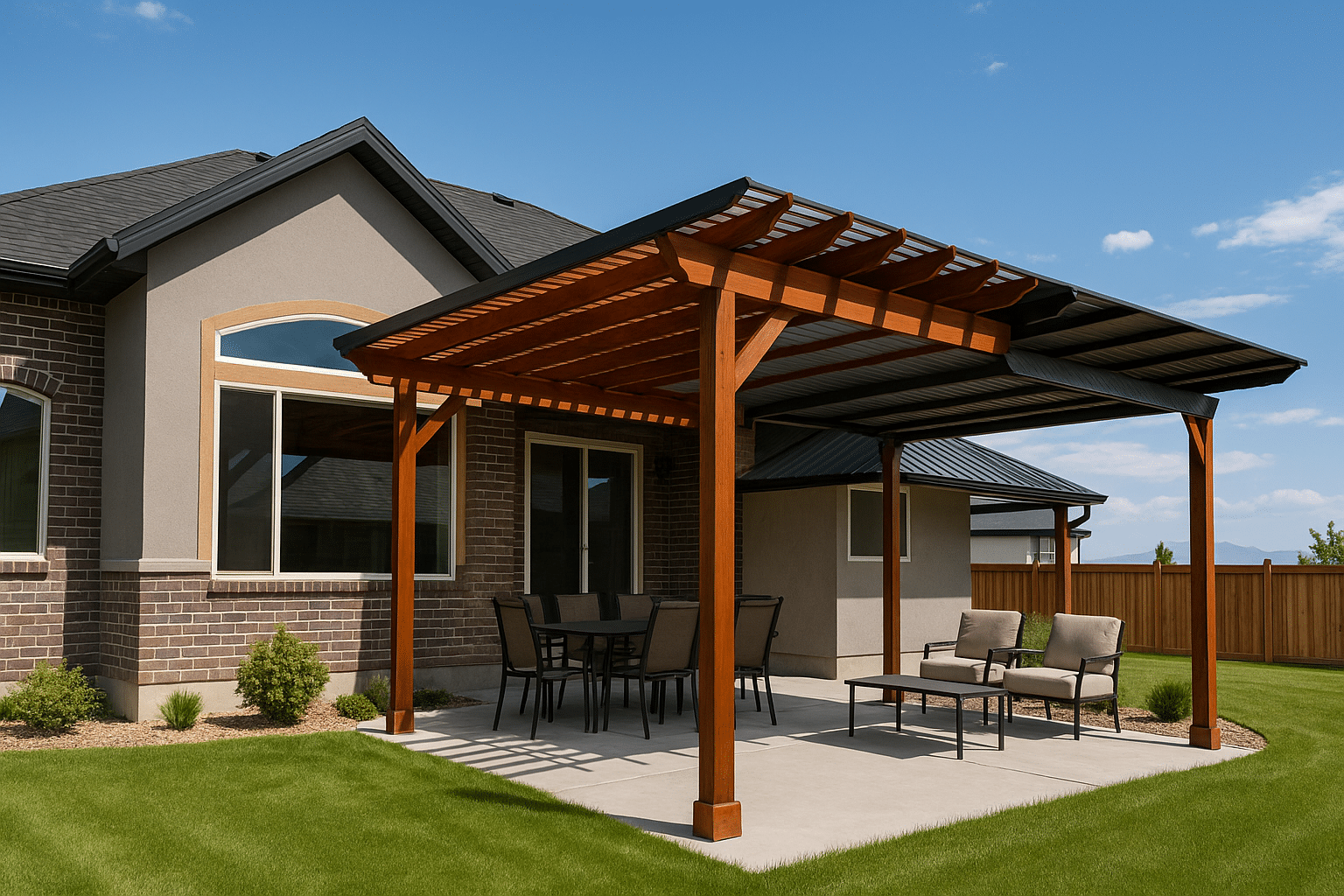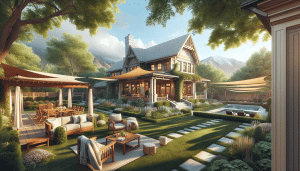Picking a roof for your pergola sounds simple—until you stand on your patio in a Salt Lake City summer, squinting at the sun, or shovel heavy, wet snow off a nearby deck in March and realize it’s anything but. Whether you’re shading a cozy nook or creating a full outdoor room, the right pergola roof can make the difference between a weekend retreat and a maintenance headache. This guide helps Salt Lake City homeowners figure out what works, why it matters, and how to choose the roof that fits your life (and your house).
Contents
- 1 Why the roof matters more than you probably thought
- 2 Common pergola roof options—and why folks pick them
- 3 Quick comparison table—at a glance
- 4 Factors Salt Lake City homeowners should weigh
- 5 Materials and finishes—match the roof to your home
- 6 Installation details and features worth considering
- 7 How to choose—step-by-step so it’s not overwhelming
- 8 Maintenance and lifespan—what to expect
- 9 Short FAQs—fast answers to common questions
- 10 Ready to pick the right roof? Let’s make it simple.
Why the roof matters more than you probably thought
Here’s the thing: a pergola roof is both practical and emotional. Practically, it manages sun, rain, snow, and wind. Emotionally, it defines how you use the space—will it feel like an open-air stage or a sheltered living room? You might love the dappled light of classic slats but then hate the afternoon glare. Or you could want total rain protection but not the boxed-in vibe that sometimes comes with a solid roof.
In Salt Lake City, moving between seasons quickly is normal. Hot, dry summers; sudden thunderstorms; and snowy winters mean your roof choice has to be versatile. Structural concerns—like roof pitch for snow shed and bracket strength for wind—matter as much as looks. And yes, local building codes and HOA rules can be strict; they often decide Materials and finishes before taste does.
Common pergola roof options—and why folks pick them
Let’s break down the usual suspects. You’ll see a lot of names thrown around, but really, it comes down to light control, protection, maintenance, and style.
Open slatted roof (Wood or aluminum)
Classic pergola look. Light filters through; you get sun and shade. If you love that gardeny, natural vibe, this is it. It’s also the least protective against rain and snow—unless you add panels or a retractable cover.
Polycarbonate panels
Clear or tinted plastic panels that let light in while blocking UV and rain. Durable, lighter than glass, and fairly affordable. They do trap heat a bit, though, and over time they can scratch or yellow if you pick a cheaper grade.
Aluminum louvered roof
Moveable blades that you can tilt or close completely. You get the best of both worlds: sunshine, shade, or full weather-proofing. Mechanized or manual systems are available; lots of homeowners love the control. They’re pricier, and the mechanism needs occasional servicing—worth it for many people.
Solid roof (metal, shingles, or standing seam)
Feels like an outdoor room. Great for heaters, fans, mounted TVs, and heavy snowfall. If you want year-round usability and a clean silhouette that matches your house, a solid roof is convincing. It does block natural light—unless you add skylights or clerestory windows—so expect a darker feel underneath.
Retractable fabric canopy
Flexible, affordable, and easy to install. Perfect for patios that shift purpose: shade on sunny afternoons, open-air evenings. Fabrics vary—from budget canvas to high-end Sunbrella that resists fading and mildew. Not ideal for heavy snow loads.
Quick comparison table—at a glance
Here’s a compact way to compare key features. It’s not exhaustive, but it makes trade-offs obvious.
| Roof Type | Pros | Cons |
|---|---|---|
| Open slats | Classic look; cool airflow; low cost | Limited weather protection; maintenance on wood |
| Polycarbonate panels | Light transmission; waterproof; affordable | Heat retention; scratching and potential yellowing |
| Aluminum louvered | Adjustable shade; weatherproof when closed | Higher cost; mechanical maintenance |
| Solid roof | Year-round use; supports fixtures and snow | Darker feel; higher structural load |
Factors Salt Lake City homeowners should weigh
Not all advice is universal. For example, a glass roof looks chic but can turn your pergola into an oven in July unless you plan ventilation. Sounds obvious, but surprises happen.
Snow load and roof pitch: Salt Lake City gets heavy, wet snow sometimes. Make sure your structure and roof type meet local snow load requirements; sometimes a steeper pitch or reinforced joists are necessary.
Sun and UV: The sun is intense at altitude. Polycarbonate blocks UV and lets light through; fabrics can fade without Sunbrella or similar high-quality textiles. Think about UV-protective finishes for wood and powder coat for metal.
Wind: Summer storms can surprise you. Consider wind ratings for screens, louvers, and fabric canopies. Anchoring is everything—bolts into concrete or properly engineered footings, not just deck screws.
HOA and permits: Many SLC neighborhoods have rules on roof materials, Colors, and heights. Call your city building department before ordering expensive parts. Honestly, skipping that step costs more time and money than you’d expect.
Materials and finishes—match the roof to your home
Match or complement—those are the choices. A Cedar pergola with natural stain suits Craftsman homes; powder-coated aluminum looks modern and pairs well with stucco. You don’t have to be matchy-matchy; contrast can be striking when done right.
Wood species: Cedar and Redwood resist rot and insects better than pressure-treated pine, but they cost more. Staining vs. painting? Stain keeps the grain visible and needs reapplication; paint gives a clean color but can peel.
Metals: Aluminum doesn’t rust and is lightweight. Steel is stronger but needs proper coatings to resist corrosion. Powder-coating saves you headaches—it’s a durable finish used by brands like Sherwin-Williams.
Thermal considerations: Materials expand and contract. Polycarbonate panels might need slip joints; metals require thermal breaks. That’s nerdy, but it matters if you want long-lasting leaks-free performance.
Installation details and features worth considering
Good installation turns a pretty pergola into a durable one. Here are the things that often get missed until it’s too late.
Drainage and gutters: Solid roofs need integrated gutters or clever flashing so water doesn’t run off into your seating area or against your house. A simple channel can make life so much easier.
Electrical and lighting: If you plan string lights, heaters, or a TV, plan wiring before the roof goes on. Reinforced headers or mounting blocks make adding lights or heavy fans easy later.
Insulation and airflow: Solid roofs retain heat. If you want to use your pergola in summer afternoons, consider ceiling fans, cross ventilation, or skylights. For winter use, think about infrared heaters and wind screens.
How to choose—step-by-step so it’s not overwhelming
Start with purpose. Ask yourself: Do I want shade, shelter, or both? Are you hosting big gatherings or craving quiet mornings with coffee?
Then check constraints: budget, HOA rules, and how much upkeep you’ll tolerate. If you’re busy, low-maintenance materials like aluminum or composite might be a relief. If you’re renovating a period home, wood could be the emotional choice.
Next, picture the season you use most. If you live outside most of the year, go for a roof that offers year-round protection. If you only need hot-day shade, a fabric canopy or polycarbonate might be perfect—and cheaper.
Finally, work with experienced installers. A well-installed mid-range roof will outperform a high-end product put on poorly. Local knowledge counts: we know which fasteners resist our winter freeze-thaw cycles and which coatings hold up to summer sun.
Maintenance and lifespan—what to expect
Different roofs mean different chores. Wood pergolas may need stain every 2–4 years; metal roofs usually need only an occasional wash and check for scratches. Polycarbonate panels might last 10–15 years with UV-treated material; cheaper panels fade faster.
Pro tip: treat fasteners and joints as living things. They loosen, corrode, and leak. Inspect connections annually; re-seal flashing after major storms. It’s boring work, but your pergola will thank you.
Short FAQs—fast answers to common questions
Q: Can I add a solid roof to an existing pergola?
A: Often yes, but you’ll likely need to reinforce beams and check footing. Retrofitting can be cost-effective if the foundation is solid.
Q: Are motorized louvers worth it?
A: If you value convenience and plan to use the space frequently, they’re worth it. If you rarely change the roof position, manual might be fine.
Q: How much does a pergola roof cost?
A: Wide range—basic polycarbonate panels on a simple frame could be a few thousand dollars, while custom aluminum louvered systems can be tens of thousands. Get quotes and compare warranties.
Q: Do I need permits?
A: In many Salt Lake City neighborhoods, yes—especially for solid roofs and structures attached to homes. Check with the city building department or your contractor.
Ready to pick the right roof? Let’s make it simple.
If you want honest, local advice that balances looks, weather, and budget—you don’t have to guess. We design and build pergolas for Salt Lake City homeowners who want outdoor spaces that actually get used. Whether you’re leaning toward aluminum louvered elegance or a warm cedar roof with polycarbonate skylights, we’ll help you weigh trade-offs and avoid the common pitfalls.
Call us at 801-784-6082 or Request a Free Quote. A quick chat can save weeks of research—and some regrets. Utah Pergola Company knows the local codes, the weather quirks, and the finishes that hold up here. Let’s build something you’ll love.




